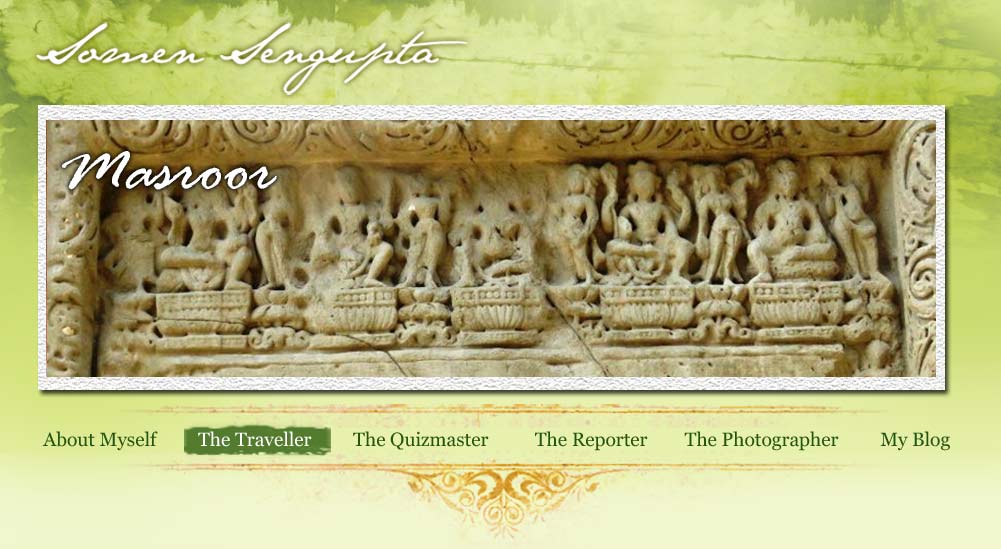| MASROOR : UNEXPLORED ELLORA OF THE HIMALAYA |
|
The art of rock cut monolithic temple was mastered by sculptors in ancient India and the best example of that are found in Kailash temple of Ellora in Maharashtra and Maharathas
of Mahabalipuram in Tamilnadu. While these two archaeological sites are frequented by visitors, another semi ruined rock cut temple complex situated at 2535 ft from sea level under the shadow of breathtaking panorama of Himalaya is largely unexplored. The unknown cousin of Kailash temple of Ellora is known as Masroor.
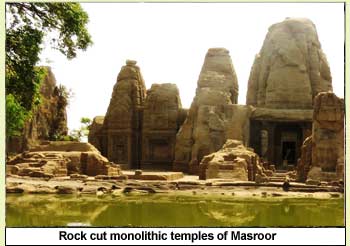 The amazing 8th century temple complex in the Kangra valley does not feature in travel plan of most of the travellers and it's reference in internet is also very limited. An insipid drive of 38 km on the dust clad road from Kangra comes to an end where a small board planted by Himachal Pradesh Tourism Development Corporation ( HPTDC ) avows a direction to a rock cut temple complex. Soon the grand structure of a semi ruined rock edict emerges to it's visitors. Known as Masroor temple complex the 1300 years old Shiva temples carved out from ridge of sand stone by unknown sculptors still mesmerises every soul that comes under shadow of this. The marvel of ancient engineering and devotion to God peacefully coexist in Masroor. The amazing 8th century temple complex in the Kangra valley does not feature in travel plan of most of the travellers and it's reference in internet is also very limited. An insipid drive of 38 km on the dust clad road from Kangra comes to an end where a small board planted by Himachal Pradesh Tourism Development Corporation ( HPTDC ) avows a direction to a rock cut temple complex. Soon the grand structure of a semi ruined rock edict emerges to it's visitors. Known as Masroor temple complex the 1300 years old Shiva temples carved out from ridge of sand stone by unknown sculptors still mesmerises every soul that comes under shadow of this. The marvel of ancient engineering and devotion to God peacefully coexist in Masroor.
History is painfully silent about those who many years ago took such an audacious engineering plan to carve out 19 temples from a solid rock mass. As history is absent and no dedicatory stone tablet with inscription was found, local folklore have invaded to shape legend that goes well with common people. Legend has it that this temple is connected with Hindu epic Mahabharata where Pandavas during their one year exile life in forest came here and decided to construct a stone stair that goes straight to heaven from earth. Challenge was taken to finish the work before next sunrise. Knowing this, a worried Indra the king of Gods, took the form of a rooster and cock-a-doodled-do much before of the breaking of the dawn. Thinking the dawn is broken, Pandavas abandoned the job and on the same place these astonishing temples came out of rock.
If this folklore can be ignored then the time of the temple construction can be derived from it's archaeological form. Stylistically it is very close to Indo Aryan or known as nagara temple a school that boomed at the late stage of Gupta era this can be concluded that royal family of Katoj that ruled from Kangra and whose kingdom was known as Jalandhara or Trigatra built thistemple.It is believed that this royal race was founded by one Susarama Chandra the father-in-law of Duryadhana of Mahabharata. Two exceptional factors make Masroor a thrilling place. One is how a plan of monolithic temple which is mostly found in peninsular India was planned in a valley of Himalaya and next is what makes the planner to leave such a grand project incomplete.
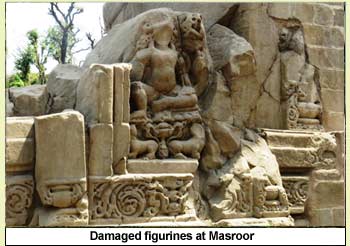 A tough place to reach even today the location of Masroor saved it from the plunder of Islamic invaders lead by Mohammad Ghazni and Firoz Shah Tuhglak. It is surprising that Ghazani who reduced Kangra fort to rubble in 10th century at a cost of thousand deaths and loot overlooked this temple. Thanks to the hidden presence inside of dense jungle in those days it escaped from a big human sin. Next many centuries Masroor was visited only by handful of local religious persons till the year 1875 when some Europeans rediscovered this gem. Meanwhile on 4th April 1904 the devastating earthquake in Kangra valley practically smashed all structures of the area and caused massive damage to the temples. A tough place to reach even today the location of Masroor saved it from the plunder of Islamic invaders lead by Mohammad Ghazni and Firoz Shah Tuhglak. It is surprising that Ghazani who reduced Kangra fort to rubble in 10th century at a cost of thousand deaths and loot overlooked this temple. Thanks to the hidden presence inside of dense jungle in those days it escaped from a big human sin. Next many centuries Masroor was visited only by handful of local religious persons till the year 1875 when some Europeans rediscovered this gem. Meanwhile on 4th April 1904 the devastating earthquake in Kangra valley practically smashed all structures of the area and caused massive damage to the temples.
Soon neglect, vandalism, weathering, erosion and other causes made the temple complex a stock yard of debris. British Government realised it's profound historical significance. It was the beginning of rediscovering north India's only monolithic temple complex and soon Archaeological Survey of India undertook it's responsibility to protect it. In 1913 a man named H L Shuttleworth was first to mention this unique 15 temples set complex and British Government realising its historical& archaeological importance announced it as a national monument in 1914. An article by H Hargreaves titled "The Monolithic Temple Of Masroor" published in the annual issue of ASI in 1915 gave this complex an international exposure. A year later in 1916 chief draft-man of ASI M Ghulam did a complete mapping of this giant structure.
It is assumed that before 1905 earthquake 19 temples were housed inside this complex. Today after that devastating natural calamity only 15 temples survived where a huge central shrine dominates the group and subordinating temples stand on both sides. Carved from a ridge of sandstone the 170 ft long and 120 ft widen temple complex has an amazing similarity with Ankor Wat temple complex of Cambodia world's biggest temple complex built between 9th to 14th century. Compared to that this Masroor is much older and was much bigger a challenge to create.
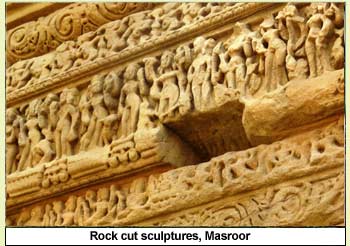 Also known as Himalayan pyramid for it's unique shape Masroor group of temple runs from north east to south east and face the breathtaking panorama of Dhauladhar range of Himalaya and the green valley of Beas. A close observation will reveal that only the central shrine was cut from inside while all other temples were carved from outside. The central shrine was once dedicated to lord Shiva but now image of Rama, Sita and Laxmana are placed inside of it. The entrance is decorated with four giant pillars and all are partly broken. Tower of the temples are covered with intricate stone carving. The sanctum sanctorum of the central temple is known as Thakurdwara the door of God. This temple is in use now. The superb black stone door of Thakurdwara which is 15 mt in height is decorated with plethora of Hindu God and Goddess along with various Hindu motifs like kaalas, lotus and various floral designs. Also known as Himalayan pyramid for it's unique shape Masroor group of temple runs from north east to south east and face the breathtaking panorama of Dhauladhar range of Himalaya and the green valley of Beas. A close observation will reveal that only the central shrine was cut from inside while all other temples were carved from outside. The central shrine was once dedicated to lord Shiva but now image of Rama, Sita and Laxmana are placed inside of it. The entrance is decorated with four giant pillars and all are partly broken. Tower of the temples are covered with intricate stone carving. The sanctum sanctorum of the central temple is known as Thakurdwara the door of God. This temple is in use now. The superb black stone door of Thakurdwara which is 15 mt in height is decorated with plethora of Hindu God and Goddess along with various Hindu motifs like kaalas, lotus and various floral designs.
Many of these are symbol of fertility. The arch panel, corner panel, base frieze are all richly embellished with innumerable human and animal figures and some of them are really interesting like couples in semi erotic postures - a common theme in Orissa temple. Apart from that image of Ganesha, Durga, Kubera, Varuna, Shiva, Yama, Indra, Uma and Skanda are prominently visible. Iconography on the wall of this temple is simple yet interesting. Many of the figures are on the wall and some are on the floor as a piece of debris. Both sides of the main entrance of central shrine have a provision to go upstairs and to boost the legend of Pandava's incomplete stairs to heaven even today a flight of rock stairs are there.
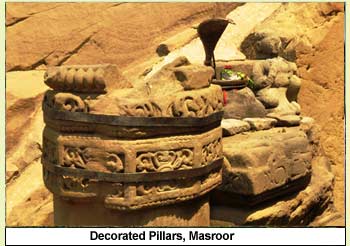 Though not many photographic evidence of this temple before 1904 earthquake are available it is quite clear that a huge stone roof plate was once placed on the portico of the main temple and later that was grounded. Debris that scattered all over is testimony of that fact. Each and every fragment of that debris also contains rich stone carving expressing various images of Hindu deities and motifs. On the south side there are two unfinished porticos. Western side is less damaged and it's roof plate still exists. One can find image of seated Laxmi with five female deities on the north while on the eastern porch takes the position of honour with seven deities. The best view of Masroor group of temple is from it's front on the edge of a rectangular water tank where it's majestic shadow is reflected. This water tank was added much later and now properly maintained for the beautification of the complex. Many artifacts like a stone elephant, the tower crown, bottom of pillars and many human figures which all were fallen and broken in 1904 earthquake are on display. Though not many photographic evidence of this temple before 1904 earthquake are available it is quite clear that a huge stone roof plate was once placed on the portico of the main temple and later that was grounded. Debris that scattered all over is testimony of that fact. Each and every fragment of that debris also contains rich stone carving expressing various images of Hindu deities and motifs. On the south side there are two unfinished porticos. Western side is less damaged and it's roof plate still exists. One can find image of seated Laxmi with five female deities on the north while on the eastern porch takes the position of honour with seven deities. The best view of Masroor group of temple is from it's front on the edge of a rectangular water tank where it's majestic shadow is reflected. This water tank was added much later and now properly maintained for the beautification of the complex. Many artifacts like a stone elephant, the tower crown, bottom of pillars and many human figures which all were fallen and broken in 1904 earthquake are on display.
From this side of the water tank the entire complex comes in single frame and it's astonishing resemblance with Angkor Wat can be felt. At twilight and dawn the beam of sun gives a bath of light to the yellow sandstone of Masroor and that reveals a magical extra ordinary splendour. More than 1300 years after it's establishment and sudden abortion before it could take a complete shape, Masroor temples stand like a living tower of glory from which rich heritage of this land whispers in a modest yet absolute clear voice.
Travel Logistics
Masroor temple complex is 40 km from Kangra fort one of most frequently visited monument of Himachal Pradesh. It is just 9 km from Haripur town well connected from Delhi, Chandigargh and MacLeodganj. Nearest airport is Gaggal or Kangra airport. A day visit is enough - try to reach early morning for better photography. The monument is ASI protected and there is an entry fee. Do not expect a guide - do your homework well. Basic food and packed snacks are available.
This article was published on 12th July 2015 in The Hitavada
Click here to view the original article |
